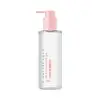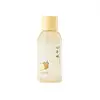What's inside
What's inside
 Key Ingredients
Key Ingredients

 Benefits
Benefits

 Concerns
Concerns

No concerns
 Ingredients Side-by-side
Ingredients Side-by-side

Cetyl Ethylhexanoate
EmollientSorbeth-30 Tetraoleate
EmulsifyingCaprylic/Capric Triglyceride
MaskingHelianthus Annuus Seed Oil
EmollientOryza Sativa Bran Oil
EmollientLactobacillus/Soymilk Ferment Filtrate
Skin ConditioningCapryloyl Salicylic Acid
ExfoliatingSaccharomyces/Rice Ferment Filtrate
Skin ConditioningSaponaria Officinalis Leaf Extract
AntimicrobialTocopherol
AntioxidantButylene Glycol
HumectantPentylene Glycol
Skin ConditioningWater
Skin ConditioningCaprylyl Glycol
Emollient1,2-Hexanediol
Skin ConditioningCetyl Ethylhexanoate, Sorbeth-30 Tetraoleate, Caprylic/Capric Triglyceride, Helianthus Annuus Seed Oil, Oryza Sativa Bran Oil, Lactobacillus/Soymilk Ferment Filtrate, Capryloyl Salicylic Acid, Saccharomyces/Rice Ferment Filtrate, Saponaria Officinalis Leaf Extract, Tocopherol, Butylene Glycol, Pentylene Glycol, Water, Caprylyl Glycol, 1,2-Hexanediol
Helianthus Annuus Seed Oil
EmollientEthylhexyl Palmitate
EmollientCoco-Caprylate/Caprate
EmollientCetyl Ethylhexanoate
EmollientSorbeth-30 Tetraoleate
EmulsifyingCetearyl Ethylhexanoate
EmollientCaprylyl Glycol
EmollientTocopheryl Acetate
AntioxidantEthylhexylglycerin
Skin ConditioningCitrus Aurantium Dulcis Oil
MaskingPelargonium Graveolens Flower Oil
MaskingBenzotriazolyl Dodecyl P-Cresol
UV AbsorberLavandula Angustifolia Oil
MaskingOcimum Basilicum Oil
MaskingCitrus Limon Fruit Extract
MaskingRosmarinus Officinalis Leaf Oil
MaskingCitrus Grandis Peel Oil
MaskingSalvia Sclarea Oil
MaskingWater
Skin ConditioningPyrus Pyrifolia Fruit Extract
Emollient1,2-Hexanediol
Skin ConditioningCapryloyl Salicylic Acid
ExfoliatingPanthenol
Skin ConditioningButylene Glycol
HumectantFicus Carica Fruit Extract
HumectantPantolactone
HumectantMentha Aquatica Leaf Extract
Skin ConditioningVitis Vinifera Fruit Extract
Skin ConditioningDiospyros Kaki Leaf Extract
Skin ProtectingCoffea Arabica Seed Extract
MaskingPolygonum Cuspidatum Root Extract
AntioxidantCarthamus Tinctorius Flower Extract
Skin ConditioningCamellia Sinensis Leaf Extract
AntimicrobialCastanea Crenata Shell Extract
Skin ConditioningZanthoxylum Piperitum Fruit Extract
Skin ConditioningLimonene
PerfumingLinalool
PerfumingCitronellol
PerfumingHelianthus Annuus Seed Oil, Ethylhexyl Palmitate, Coco-Caprylate/Caprate, Cetyl Ethylhexanoate, Sorbeth-30 Tetraoleate, Cetearyl Ethylhexanoate, Caprylyl Glycol, Tocopheryl Acetate, Ethylhexylglycerin, Citrus Aurantium Dulcis Oil, Pelargonium Graveolens Flower Oil, Benzotriazolyl Dodecyl P-Cresol, Lavandula Angustifolia Oil, Ocimum Basilicum Oil, Citrus Limon Fruit Extract, Rosmarinus Officinalis Leaf Oil, Citrus Grandis Peel Oil, Salvia Sclarea Oil, Water, Pyrus Pyrifolia Fruit Extract, 1,2-Hexanediol, Capryloyl Salicylic Acid, Panthenol, Butylene Glycol, Ficus Carica Fruit Extract, Pantolactone, Mentha Aquatica Leaf Extract, Vitis Vinifera Fruit Extract, Diospyros Kaki Leaf Extract, Coffea Arabica Seed Extract, Polygonum Cuspidatum Root Extract, Carthamus Tinctorius Flower Extract, Camellia Sinensis Leaf Extract, Castanea Crenata Shell Extract, Zanthoxylum Piperitum Fruit Extract, Limonene, Linalool, Citronellol
 Reviews
Reviews

Ingredients Explained
These ingredients are found in both products.
Ingredients higher up in an ingredient list are typically present in a larger amount.
1,2-Hexanediol is a synthetic liquid and another multi-functional powerhouse.
It is a:
- Humectant, drawing moisture into the skin
- Emollient, helping to soften skin
- Solvent, dispersing and stabilizing formulas
- Preservative booster, enhancing the antimicrobial activity of other preservatives
Butylene Glycol (or BG) is used within cosmetic products for a few different reasons:
Overall, Butylene Glycol is a safe and well-rounded ingredient that works well with other ingredients.
Though this ingredient works well with most skin types, some people with sensitive skin may experience a reaction such as allergic rashes, closed comedones, or itchiness.
Learn more about Butylene GlycolCapryloyl Salicylic Acid comes from salicylic acid, the famous acne-fighting BHA.
It usually goes by a more common name of LHA, or lipohydroxy acid.
Like salicylic acid, this ingredient is a chemical exfoliant that can help break down the oil in your pores and reduce inflammation.
Though studies for LHA do show it to be less effective than salicylic acid. To be fair, salicylic acid is the reigning monarch of acne treatments.
However, a study from 2009 found LHA to be comparable to BPO, making it a good alternative for people with sensitive skin. Another study of 14 patients found a significant decrease in comedones after using LHA.
Another pro of LHA? It is less irritating than salicylic acid due to its large molecule size.
Large molecules cannot penetrate skin as well, so they are gentler on the skin. LHA is much less penetrative than salicylic acid.
An in-vitro study (not done on a living organism) found only 6% of LHA penetrated past the statum corneum compared to 58% of salicylic acid. An in-vivo (done on a living organism) analysis revealed ~17% of LHA was still present in the top layer of skin after 4 days, versus ~9% of salicylic acid.
Interestingly, a study from 2008 found LHA comparable to another famous acid, glycolic acid.
This study found about 10% of LHA is as effective as 20-50% of glycolic acid in treating hyperpigmentation and fine-lines.
Hydroxy acids have been found to stimulate skin protein, lipids, and thermal thickening. This may have anti-aging benefits.
Learn more about Capryloyl Salicylic AcidCaprylyl Glycol is a humectant and emollient, meaning it attracts and preserves moisture.
It is a common ingredient in many products, especially those designed to hydrate skin. The primary benefits are retaining moisture, skin softening, and promoting a healthy skin barrier.
Though Caprylyl Glycol is an alcohol derived from fatty acids, it is not the kind that can dry out skin.
This ingredient is also used as a preservative to extend the life of products. It has slight antimicrobial properties.
Learn more about Caprylyl GlycolCetyl Ethylhexanoate is an emollient ester. It comes from cetearyl alcohol and 2-ethylhexanoic acid.
Cetyl Ethylhexanoate is an emollient that adds a velvety feel to skin without being greasy or oily. Emollients help trap moisture into your skin, keeping your skin soft and hydrated.
Helianthus Annuus Seed Oil is the oil derived from the seeds of a Sunflower. Sunflower seed oil is non-fragrant. It is an emollient, meaning it helps to soften the skin.
Sunflower seed oil contains many fatty acids. The fatty acids found in sunflower seeds include (from highest amount to least): linoleic acid, myristic acid, palmitic acid, stearic acid, arachidic acid, oleic acid, and linolenic acid.
These fatty acids help the skin create ceramides. Ceramides play a role in repairing the skin barrier.
Helianthus Annuus Seed Oil helps moisturize the skin. This in turn helps the skin look more rejuvenated and smoother.
Sunflowers are rich in vitamin E.
Historians believe Indigenous cultures of North America domesticated sunflowers before corn. Thus they relied on sunflower oil for a variety of uses. One such use is moisturizing skin and hair.
Sunflower seed oil may not be fungal acne safe. We recommend speaking with a professional if you have any concerns.
Learn more about Helianthus Annuus Seed OilSorbeth-30 Tetraoleate is a surfactant and emulsifier.
This ingredient is a tetraester from oleic acid and polyethylene glycol ether of sorbitol.
As an emulsifier, it helps ingredients such as oil and water mix together. This allows the dirt and oils in your skin to be washed away.
One study found pumpkin oil containing Sorbeth-30 Tetraoleate helped hydrate the skin and did not cause any irritation.
Learn more about Sorbeth-30 TetraoleateWater. It's the most common cosmetic ingredient of all. You'll usually see it at the top of ingredient lists, meaning that it makes up the largest part of the product.
So why is it so popular? Water most often acts as a solvent - this means that it helps dissolve other ingredients into the formulation.
You'll also recognize water as that liquid we all need to stay alive. If you see this, drink a glass of water. Stay hydrated!
Learn more about Water